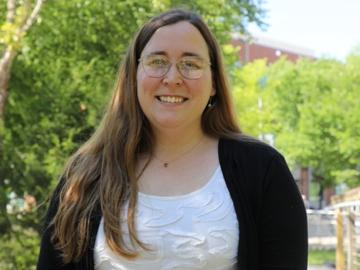
Filter News
Area of Research
- Advanced Manufacturing (4)
- Biology and Environment (60)
- Biology and Soft Matter (1)
- Building Technologies (1)
- Computational Biology (1)
- Computational Engineering (3)
- Computer Science (14)
- Energy Science (57)
- Fuel Cycle Science and Technology (1)
- Fusion and Fission (28)
- Fusion Energy (11)
- Isotope Development and Production (1)
- Isotopes (27)
- Materials (44)
- Materials for Computing (8)
- Mathematics (1)
- National Security (34)
- Neutron Science (20)
- Nuclear Science and Technology (38)
- Nuclear Systems Modeling, Simulation and Validation (1)
- Quantum information Science (5)
- Supercomputing (124)
News Type
News Topics
- (-) Computer Science (216)
- (-) Cybersecurity (34)
- (-) Frontier (61)
- (-) Isotopes (58)
- (-) Mercury (12)
- (-) Molten Salt (10)
- (-) Nuclear Energy (113)
- (-) Software (1)
- (-) Space Exploration (26)
- 3-D Printing/Advanced Manufacturing (137)
- Advanced Reactors (37)
- Artificial Intelligence (127)
- Big Data (70)
- Bioenergy (109)
- Biology (126)
- Biomedical (70)
- Biotechnology (38)
- Buildings (65)
- Chemical Sciences (83)
- Clean Water (32)
- Composites (33)
- Coronavirus (47)
- Critical Materials (28)
- Education (5)
- Element Discovery (1)
- Emergency (4)
- Energy Storage (107)
- Environment (202)
- Exascale Computing (65)
- Fossil Energy (8)
- Fusion (63)
- Grid (70)
- High-Performance Computing (125)
- Hydropower (12)
- Irradiation (2)
- ITER (9)
- Machine Learning (64)
- Materials (147)
- Materials Science (145)
- Mathematics (11)
- Microelectronics (4)
- Microscopy (51)
- Nanotechnology (58)
- National Security (81)
- Neutron Science (163)
- Partnerships (68)
- Physics (64)
- Polymers (31)
- Quantum Computing (52)
- Quantum Science (90)
- Security (29)
- Simulation (61)
- Statistics (4)
- Summit (70)
- Transportation (92)
Media Contacts
Verónica Melesse Vergara and Felipe Polo-Garzon, two staff members at ORNL have been honored with Luminary Awards from Great Minds in STEM, a nonprofit organization dedicated to promoting STEM careers in underserved communities.

A team of researchers used the Frontier supercomputer and a new methodology for conducting a genome-wide association study to earn a finalist nomination for the Association for Computing Machinery’s 2024 Gordon Bell Prize for outstanding

A multi-institutional team of researchers led by the King Abdullah University of Science and Technology, or KAUST, Saudi Arabia, has been nominated for the Association for Computing Machinery’s 2024 Gordon Bell Prize for Climate Modelling.

Plants the world over are absorbing about 31% more carbon dioxide than previously thought. The research, detailed in the journal Nature, is expected to improve Earth system simulations that scientists use to predict the future climate, and spotlights the importance of natural carbon sequestration for greenhouse gas mitigation.

Researchers led by the University of Melbourne, Australia, have been nominated for the Association for Computing Machinery’s 2024 Gordon Bell Prize in supercomputing for conducting a quantum molecular dynamics simulation 1,000 times greater in size and speed than any previous simulation of its kind.

To bridge the gap between experimental facilities and supercomputers, experts from SLAC National Accelerator Laboratory are teaming up with other DOE national laboratories to build a new data streaming pipeline. The pipeline will allow researchers to send their data to the nation’s leading computing centers for analysis in real time even as their experiments are taking place.

Prasanna Balprakash, director of AI programs for ORNL, discussed advancing climate and weather research through high performance computing and artificial intelligence as part of a September 18 panel for the United States Senate.

Karly Harrod, recipient of the Early Career Competition Laboratory Directed Research and Development award at ORNL, is focused on extracting disease data from reports. Passionate about global health, she looks forward to applying her expertise to climate data within the geospatial science and human security division.

A study led by the Department of Energy’s Oak Ridge National Laboratory details how artificial intelligence researchers created an AI model to help identify new alloys used as shielding for housing fusion applications components in a nuclear reactor. The findings mark a major step towards improving nuclear fusion facilities.

The Oak Ridge Leadership Computing Facility welcomed users to an interactive meeting at the Department of Energy’s Oak Ridge National Laboratory from Sept. 10–11 for an opportunity to share achievements from the OLCF’s user programs and highlight requirements for the future.


